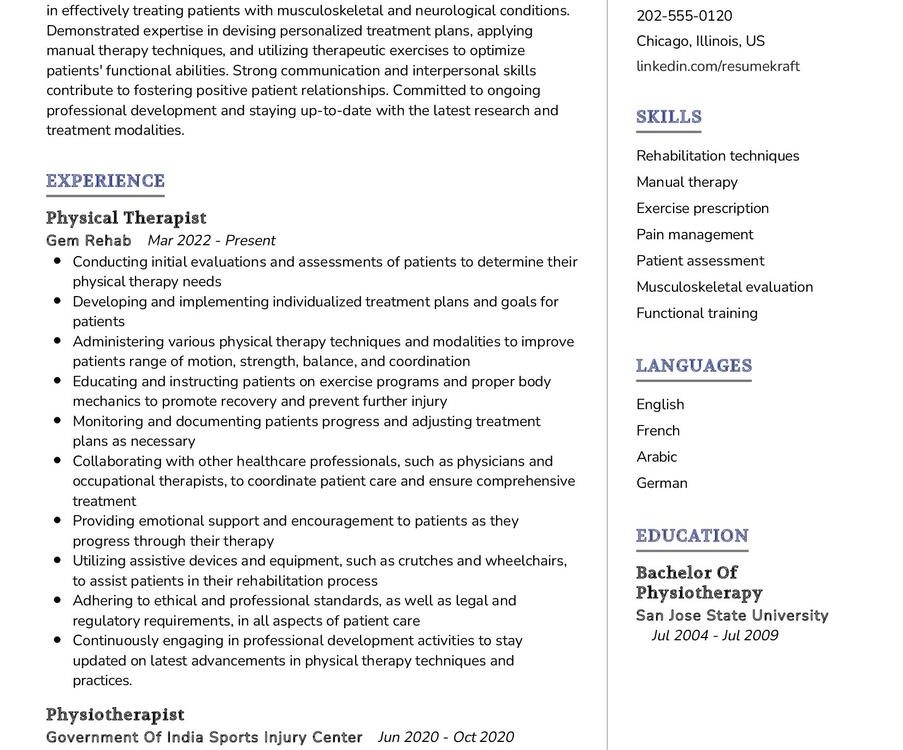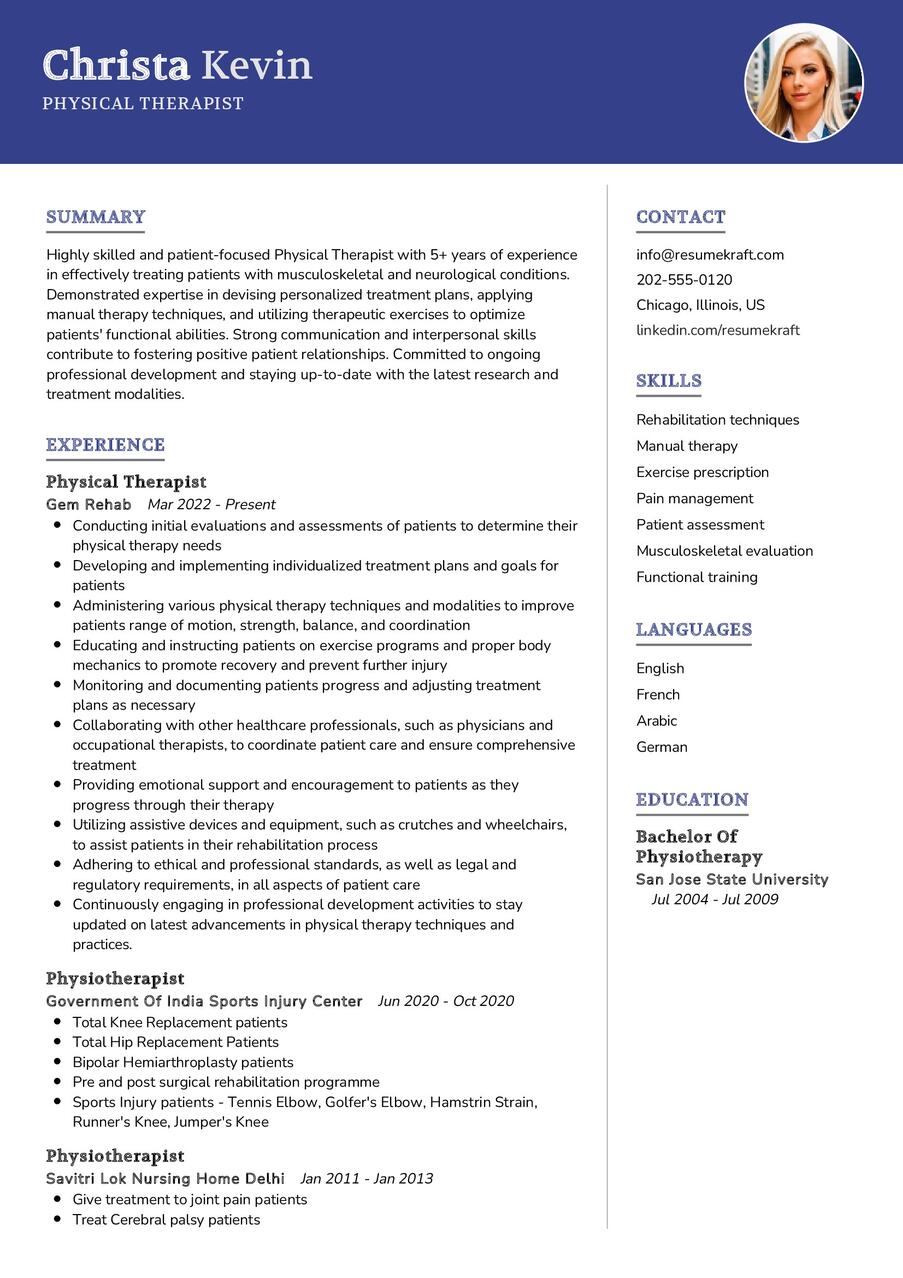What is the Role of a Physical Therapist?
As the healthcare field continues to evolve, the role of a Physical Therapist has become increasingly vital in promoting wellness and aiding in the recovery of individuals with physical ailments. This position requires a unique blend of medical expertise and compassionate care, guiding patients towards improved mobility and functionality. Let’s delve deeper into the multifaceted role of a Physical Therapist, a profession that demands a deep understanding of human anatomy and the ability to provide personalized therapeutic interventions.
A Physical Therapist is responsible for assessing patients’ physical conditions, developing customized treatment plans, and implementing therapeutic exercises to enhance their overall well-being. They work closely with patients to alleviate pain, improve mobility, and prevent or rehabilitate injuries. Beyond the technical skills, a successful Physical Therapist is also an effective communicator, collaborating with other healthcare professionals and educating patients on self-care techniques.
What are the Physical Therapist Job Requirements?
Embarking on the journey to become a Physical Therapist involves meeting specific requirements, a path that demands dedication and continuous learning. Let’s explore the prerequisites one needs to fulfill to excel in the role of a Physical Therapist:
- A Doctor of Physical Therapy (DPT) degree from an accredited program, showcasing a strong foundation in the medical domain.
- In-depth knowledge of anatomy, physiology, and biomechanics, forming the basis of effective therapeutic interventions.
- Clinical experience in physical therapy, demonstrating hands-on skills and a trajectory of increasing responsibility in patient care.
- Strong interpersonal and communication skills, crucial for building trust with patients and collaborating with healthcare teams.
- Empathy and compassion, essential qualities for understanding and addressing the unique needs of each patient.
- Adaptability to various healthcare settings, including hospitals, clinics, or rehabilitation centers.
Continuing education and staying updated on the latest advancements in physical therapy are essential for a thriving career in this dynamic field.
What are the Responsibilities of a Physical Therapist?
The role of a Physical Therapist involves a diverse range of responsibilities, each aimed at promoting optimal physical health and functionality in patients. Let’s unravel the core responsibilities that define this role, highlighting the dedication, expertise, and care that a Physical Therapist brings to their practice:
- Conducting thorough assessments of patients’ physical conditions, including range of motion, strength, and functional abilities.
- Developing and implementing personalized treatment plans, utilizing therapeutic exercises, manual therapy, and other modalities.
- Educating patients on proper body mechanics and injury prevention strategies, empowering them to take an active role in their recovery.
- Collaborating with physicians, nurses, and other healthcare professionals to ensure holistic patient care.
- Monitoring and documenting patients’ progress, adjusting treatment plans as needed for optimal outcomes.
- Staying informed about advancements in physical therapy techniques and integrating evidence-based practices into daily care.
Each responsibility requires a combination of technical expertise, empathy, and effective communication, making a significant impact on patients’ lives.
Physical Therapist CV Writing Tips
Crafting a CV as a Physical Therapist is an opportunity to showcase not only your education and experience but also your commitment to compassionate patient care. Here are some tips to help you create a compelling CV that stands out:
- Highlight your clinical experience, emphasizing specific cases where you achieved positive outcomes for patients.
- Detail any specialized certifications or training you’ve completed, showcasing your dedication to continuous learning.
- Include metrics or patient success stories, quantifying your impact on individuals’ physical health and well-being.
- Personalize your CV for each application, aligning your skills and experiences with the specific job requirements.
Each tip is a tool in your CV-writing toolbox, helping you paint a comprehensive picture of your skills and contributions as a Physical Therapist.
Physical Therapist CV Summary Examples
Your CV summary is the opening act of your professional story, providing a snapshot of your skills, experiences, and the value you bring to the table. Here are some examples to inspire you:
- “Dedicated Physical Therapist with a Doctor of Physical Therapy degree and five years of clinical experience. Passionate about empowering patients through personalized care and evidence-based interventions.”
- “Experienced Physical Therapist specializing in orthopedic rehabilitation, adept at developing comprehensive treatment plans to enhance patients’ functional abilities and quality of life.”
- “Compassionate Doctor of Physical Therapy with a focus on pediatric care. Proven track record of helping young patients achieve developmental milestones through targeted interventions.”
Each summary is a window into your professional journey, providing a glimpse of your expertise and dedication as a Physical Therapist.
Create a Strong Experience Section for Your Physical Therapist CV
Your experience section is the heart of your CV, where you detail the impactful moments in your career. Here are some examples to guide you:
- “Led a team of physical therapy professionals in a busy rehabilitation clinic, achieving a 15% improvement in patient satisfaction scores.”
- “Implemented a community outreach program, providing educational workshops on injury prevention and promoting the importance of physical activity.”
- “Collaborated with interdisciplinary teams to develop and implement innovative treatment plans for patients with complex medical conditions.”
Each experience is a chapter in your professional story, illustrating your contributions and successes as a Physical Therapist.
Sample Education Section for Your Physical Therapist CV
Your educational journey is the foundation of your career, showcasing your commitment to excellence in physical therapy. Here’s how you can list your educational milestones:
- Doctor of Physical Therapy (DPT), XYZ University, a comprehensive program focused on evidence-based practice and patient-centered care, 2016.
- Bachelor of Science in Kinesiology, ABC University, providing a strong foundation in human movement sciences, 2013.
- Board-Certified Orthopedic Clinical Specialist (OCS), a credential demonstrating advanced expertise in orthopedic physical therapy, 2018.
Each educational qualification is a stepping stone, contributing to your expertise as a Physical Therapist.
Physical Therapist Skills for Your CV
Your skill set as a Physical Therapist is your toolkit, equipped with a diverse range of abilities honed over the years. It is a showcase of your commitment to patient care and professional excellence. Let’s list down the essential skills that a Physical Therapist should possess:
Soft Skills:
- Empathy and compassion, essential for understanding and addressing patients’ unique needs.
- Communication and interpersonal skills, facilitating effective interactions with patients and collaborating healthcare professionals.
- Problem-solving abilities, the knack of finding solutions to challenges in patient care.
- Attention to detail, ensuring thorough assessments and accurate documentation of patient progress.
- Adaptability and resilience, the ability to adjust treatment plans based on individual patient responses.
Hard Skills:
- Manual therapy techniques, demonstrating hands-on skills in alleviating musculoskeletal pain and dysfunction.
- Therapeutic exercise prescription, tailoring regimens to address specific patient needs and goals.
- Knowledge of rehabilitation technologies, staying updated on advancements in equipment and modalities.
- Electronic medical record (EMR) proficiency, ensuring accurate and efficient documentation of patient care.
- Interdisciplinary collaboration, working seamlessly with other healthcare professionals to provide holistic patient care.
Each skill is a tool, contributing to your effectiveness as a Physical Therapist in providing exceptional care.
Most Common Mistakes to Avoid When Writing a Physical Therapist CV
As you craft your CV, it is essential to steer clear of common pitfalls that can hinder your journey to landing your dream job. Here we list down the mistakes often seen in CVs and how to avoid them:
- Using generic language, a strategy that fails to showcase your unique skills and experiences.
- Listing duties without showcasing your achievements, providing a shallow view of your impact as a Physical Therapist.
- Overlooking the importance of a cover letter, a missed opportunity to express your passion for the field and align your experiences with the job requirements.
- Using technical jargon without providing context, potentially alienating non-medical professionals reviewing your CV.
- Failing to proofread, a mistake that can leave a negative impression on potential employers.
Each mistake is a potential roadblock; avoid them to craft a CV that authentically showcases your skills and experiences as a Physical Therapist.
Key Takeaways for Your Physical Therapist CV
As we reach the end of this comprehensive guide, let’s recap the key points to keep in mind while crafting your Physical Therapist CV:
- Emphasize your clinical experience, highlighting specific cases where you made a positive impact on patients’ lives.
- Showcase your commitment to continuous learning, including any specialized certifications or training you’ve undertaken.
- Detail your contributions in previous roles, quantifying your achievements where possible.
- Personalize your CV for each application, aligning your skills and experiences with the specific job requirements.
Finally, feel free to utilize resources like AI CV Builder, CV Design, CV Samples, CV Examples, CV Skills, CV Help, CV Synonyms, and Job Responsibilities to create a standout application and prepare for the Physical Therapist job interview.
Armed with these insights and tips, you are now ready to craft a CV that is a true reflection of your journey, your skills, and your aspirations. Remember, your CV is not just a document; it is a canvas where you paint your career story, a story of growth, learning, and compassionate care. Best of luck!


